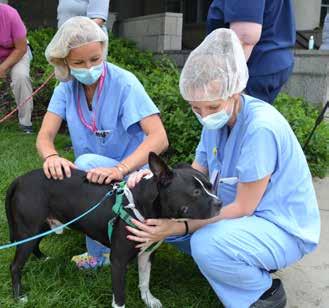
4 minute read
Number of Hospitalizations Can Be Important Clinical Indicator for Head, Neck Cancer Patients
Number of Hospitalizations Can Be Important Clinical Indicator for Head, Neck Cancer Patients Reducing stress, maintaining proper hydration and nutrition can improve survival rates, Roswell Park team shows
Patients who were unexpectedly hospitalized for dehydration, fever or other ailments while undergoing radiation treatment for head and neck cancers were at a higher risk for less favorable outcomes, a new study from Roswell Park Comprehensive Cancer Center reports.
Advertisement
Led by Anurag Singh, MD, the team found that those patients receiving radiotherapy, also known as radiation therapy, for their cancer were at a higher risk of being unexpectedly hospitalized for fever and/or dehydration either during treatment or within 90 days of receiving radiation, were at higher risk of death. The study was recently published in the journal Oral Oncology.
“While the trends we found are concerning, they highlight an important clinical indicator that has not received enough attention, and opportunities for improving both health and quality of life for our patients,” says Dr. Singh, who is Director of Radiation Research and Professor of Oncology within the Department of Radiation Medicine and Leader of the Cell Stress and Biophysical Therapy Program at Roswell Park.
The new study marks the first documentation of negative consequences of unexpected hospital admissions for head and neck cancer patients who received radiotherapy either alone or with surgery. People who are older, with advanced-stage tumors, are currently smoking and/or rely on nutritional support were more likely to have less-favorable overall survival and cancer-specific survival rates than those who completed their treatment and had adequate nutrition and hydration.
Of the 839 patients whose experiences were studied in this retroactive analysis based on data collected at Roswell Park between 2003 and 2017, 171 (20%) were hospitalized at least once after receiving radiotherapy for their cancer within 90 days of their initial treatment.
While the percentage of hospitalized patients was much lower than expected in the Roswell Park study, the investigators note that clinical outcomes were significantly better in patients who did not require unexpected hospitalization. The average overall survival rate at five years was 46% for people who had been unexpectedly hospitalized and 60.4% for those who did not require hospitalization; cancer-specific survival at five years was 58.3% for those who were hospitalized, compared to 70.1% for those who were not.
It’s common for patients treated for squamous cell head and neck cancer to report having some toxicities, like mucositis and dysphagia, sometimes combined with nausea and vomiting as a side effect from chemotherapy, which can lead to hospitalization. Patients who are at highest risk for developing these conditions should have regular conversations and check-ins with their doctor to prevent or identify developing conditions that could result in setbacks or death.
The results point to the need for good hydration for patients, and the need for clinical teams to regularly monitor and check in on their patient’s overall health, Dr. Singh says. “Providers need to see the patients as frequently as they need to be seen, not just once a week.”
The team also found that patients who completed their course of radiotherapy had better overall survival and cancerspecific survival rates than those patients who did not, and their complete response to treatment was overall better than those patients who had to cut their treatment short.
“This research changes how we understand interventions during radiation,” Dr. Singh says. “Based on these findings, we will continue to focus on improving pain control and hydration and at ways we can help make our patients fitter and more resilient with exercise for both health maintenance and improved quality of life.”
SPCA’s PAWS for LOVE Program Resumes at Mercy Hospital
SPCA’s Paws for Love program has recently been approved for stress relief events for essential workers. The first day back to work after FURRlough for these pups will be for some stress-reducing therapy at Mercy Hospital tomorrow, Tues., July 14, from 11 am to 1 pm on the Emergency Department side of the hospital front circle. There will be five pet owners with their sweet dogs to greet hospital staff, physicians, and nurses. Masks and social distancing will be required. It’s a great way to stay PAWsitive during these challenging times!
As part of the SPCA’s PAWS FOR LOVE program, run completely by volunteers, pet owners bring their gentle dogs and cats to more than 100 area healthcare facilities, nursing homes, assisted living facilities, courts, group homes, Hospice locations, children’s facilities, and area colleges.

Volunteers’ pets are evaluated by certified animal behaviorists at the SPCA and, once approved, the volunteers are put directly in touch with representatives of the facility requesting visitation so a mutually-beneficial schedule can be discussed.
Like most community outreach programs, Paws for Love has been on hold during the COVID-19 pandemic and they are excited to get back to work helping to reduce stress for our essential workers. Currently, 500+ SPCA volunteers and their pets, behavior-certified therapy teams, are part of Paws for Love.
Ashley Hardy, RRT, a respiratory therapist, pets therapy dog Georgia, a great pyreneese and Australian shepherd mix.

Mercy Hospital Nurses Sara Cutlip, RN, at left, and Liz Richert, RN cuddle with therapy dog Carlo, a mixed breed.

ADVERTISERS
St. Ann’s Community - inside front cover
MLMIC Insurance Company - back cover
Plastic Surgery Group of Rochester - pg. 26
General Physicians, PC - inside back cover
Vascular & Endovascular Center of Western NY - pg. 14
West Ridge OBGYN - pg. 4
Roswell Park - pg. 12

